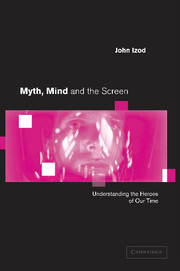Book contents
- Frontmatter
- Contents
- Acknowledgments
- Introduction
- 1 Jungian theory, textual analysis and audience play
- 2 Archetypal images: signification and the psyche
- 3 Archetypal images: symbols and the cultural unconscious
- 4 The Piano, the animus and colonial experience
- 5 The pop star as icon
- 6 The quest of a female hero: The Silence of the Lambs
- 7 Television sport and the sacrificial hero
- 8 The polycentred self: The Passion of Darkly Noon
- 9 Haunted: searching for the whole self
- 10 Transforming the final ghost: the god within
- Conclusion
- Filmography
- Glossary of Jungian and related terms
- References
- Index
1 - Jungian theory, textual analysis and audience play
Published online by Cambridge University Press: 22 September 2009
- Frontmatter
- Contents
- Acknowledgments
- Introduction
- 1 Jungian theory, textual analysis and audience play
- 2 Archetypal images: signification and the psyche
- 3 Archetypal images: symbols and the cultural unconscious
- 4 The Piano, the animus and colonial experience
- 5 The pop star as icon
- 6 The quest of a female hero: The Silence of the Lambs
- 7 Television sport and the sacrificial hero
- 8 The polycentred self: The Passion of Darkly Noon
- 9 Haunted: searching for the whole self
- 10 Transforming the final ghost: the god within
- Conclusion
- Filmography
- Glossary of Jungian and related terms
- References
- Index
Summary
While all the arts are rich treasure-houses of symbolic material, this is especially true of televisual and cinematic fiction with their ability to employ images, speech, narrative and music. Feature films and television drama are confined only by the limits of form and human imagination when they rework myth and adapt it to the needs of our time. The screen is an aesthetically rich medium, and through its sensuous pleasures spectators hope to be drawn into one or a number of diverse experiences.
How do fictions stir the spectator's psyche? The short answer is through emotion. When they view fiction and drama, most viewers expect to be recompensed for their cash outlay by being entertained. Entertainment encompasses many different kinds of delight from imaginary wish fulfilment to the pleasures of terror experienced in a virtual rather than a real milieu; from the sensuous gratifications of saturated colour and engulfing sound to the power trip of flying with a gravity-defying camera. All these forms of pleasure have in common that they appeal to and stir the emotions. Indeed, from our point of view, the significance of the well-rehearsed storytelling and generic formulae at the heart of mainstream cinema lies in the studios' recognition that the impact of emotion is potent. For the best part of a century Hollywood's executive producers have expected their writers and directors to build into almost every mainstream movie scenes which are designed to rouse strong affects in the minds of audiences.
- Type
- Chapter
- Information
- Myth, Mind and the ScreenUnderstanding the Heroes of our Time, pp. 15 - 32Publisher: Cambridge University PressPrint publication year: 2001



